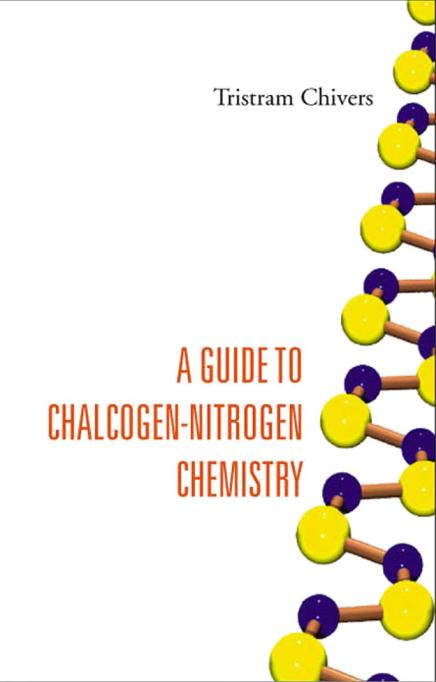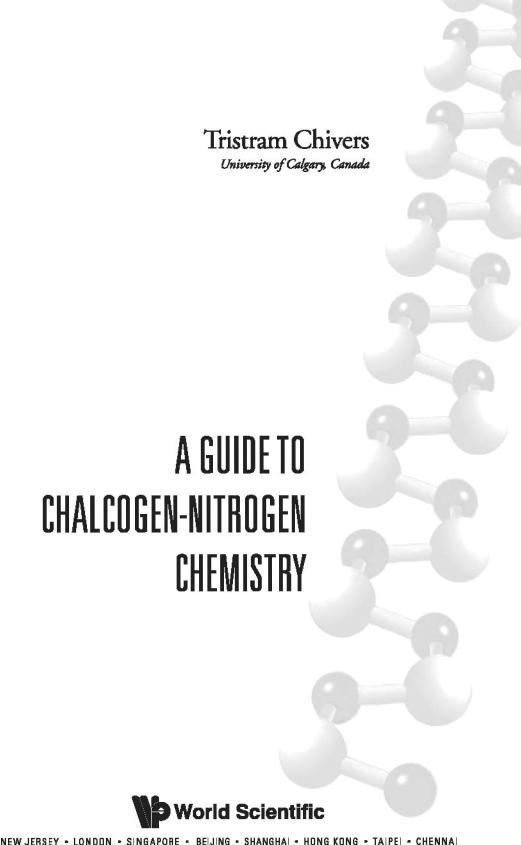
Chivers T. - A Guide to Chalcogen-Nitrogen Chemistry (2005)(en)
.pdf


Published by
World Scientific Publishing Co. Pte. Ltd.
5 Toh Tuck Link, Singapore 596224
USA office: 27 Warren Street, Suite 401-402, Hackensack, NJ 07601
UK office: 57 Shelton Street, Covent Garden, London WC2H 9HE
British Library Cataloguing-in-Publication Data
A catalogue record for this book is available from the British Library.
A GUIDE TO CHALCOGEN-NITROGEN CHEMISTRY
Copyright © 2005 by World Scientific Publishing Co. Pte. Ltd.
All rights reserved. This book, or parts thereof, may not be reproduced in any form or by any means, electronic or mechanical, including photocopying, recording or any information storage and retrieval system now known or to be invented, without written permission from the Publisher.
For photocopying of material in this volume, please pay a copying fee through the Copyright Clearance Center, Inc., 222 Rosewood Drive, Danvers, MA 01923, USA. In this case permission to photocopy is not required from the publisher.
ISBN 981-256-095-5
ISBN 981-256-133-1 (pbk)
Printed in Singapore.

Preface
The quintessential chalcogen-nitrogen compound tetrasulfur tetranitride, S4N4, was first detected by Gregory in 1835 just ten years after the discovery of benzene. Its unusual structure, like that of benzene, was not elucidated for over 100 years. The application of diffraction techniques revealed the unusual cage arrangement with two weak cross-ring sulfur– sulfur interactions. The details of the electronic structure of this fascinating molecule are still a matter of debate today.
Pioneering work in Germany, especially by the groups of BeckeGoehring, Weiss and Glemser, in the middle of the previous century uncovered a rich chemistry for inorganic sulfur–nitrogen systems. Their early efforts were notable because of the unavailability of many modern physical techniques for structural characterization that are commonplace today. The book by Goehring entitled “Ergebnisse und Probleme der Chemie der Schewfelstickstoffverbindungen” deserves special mention for the stimulus that it provided to subsequent workers in the field.
The polymer, (SN)x, was first obtained in 1910 and its metallic character was noted. However, it was the discovery in 1973 by Labes that a polymer comprised only of non-metallic elements behaves as a superconductor at 0.26 K that sparked widespread interest in sulfurnitrogen (S–N) chemistry. A year earlier Banister proposed that planar S- N heterocycles belong to a class of “electron-rich aromatics” that conform to the well known Hückel (4n + 2)Œ-electron rule of organic chemistry. This suggestion, which was based on simple electroncounting concepts, provided an additional impetus for both experimental and theoretical investigations of S–N systems. The classic book in this field “The Inorganic Heterocyclic Chemistry of Sulfur, Nitrogen and
v
vi |
Preface |
Phosphorus” by Heal covered developments up to the end of the 1970s. This opus contributed authoritative insights into the fascinating chemistry of S–N compounds. It used a descriptive approach that drew attention to the many facets of the synthesis, structures and reactions that were poorly understood at that time.
In the first chapter of his book Heal states:
“Indeed, the reaction chemistry of these substances (i.e., SN compounds) deserves to rank with that of boranes for novelty and interest”.
In the past twenty-five years the field of S–N chemistry has reached maturity as a result of contributions from many countries, notably Germany, the U.K., Canada, Japan and the United States. The combination of structural studies, primarily through X-ray crystallography, spectroscopic information and molecular orbital calculations has provided reasonable rationalizations of the structurereactivity relationships of these fascinating compounds. The unusual structures and properties of S–N compounds have attracted the attention of numerous theoretical chemists, who continue to address the “aromatic’ character of binary S–N systems. Interfaces with other areas of chemistry e.g., materials chemistry, organic synthesis, biochemistry and coordination chemistry have been established and are under active development. For example, materials with unique magnetic and conducting properties that depend on intermolecular chalcogen–nitrogen interactions between radical species have been designed. Some carbon- nitrogen-sulfur heterocycles exhibit magnetic behaviour that is of potential significance in the construction of organic data recording devices. In another area of materials chemistry, polymers involving both S–N and P–N linkages in the backbone have been used as components of matrices for oxygen sensors in the aerospace industry. In a biological setting, S-nitrosothiols (RSNO) have emerged as important species in the storage and transport of nitric oxide. As NO donors these sulfur–nitrogen compounds have potential medical applications in the treatment of blood circulation problems. In a different, but fascinating, context, thionitrite anions [SxNO]- (x = 1,2) are implicated in the gunpowder reaction through an explosive decomposition.
Preface |
vii |
The chemistry of selenium– and tellurium–nitrogen compounds has progressed more slowly but, in the last ten years, there have been numerous developments in these areas also, as a result of the creative contributions of both inorganic and organic synthetic chemists. Significant differences are apparent in the structures, reactivities and properties of these heavier chalcogen derivatives, especially in the case of tellurium. In addition, the lability of Se–N and Te–N bonds has led to applications of reagents containing these reactive functionalities in organic syntheses and, as a source of elemental chalcogen, in the production of metal chalcogenide semi-conductors.
In addition to providing a modern account of developments in chalcogen–nitrogen chemistry, including a comparison of sulfur systems with those of the heavier chalcogens, these interfaces will provide a major focus of this monograph. As implied by the inclusion of “A Guide to ….” in the title, it is not intended that the coverage of the primary literature will be comprehensive. Rather it provides an overview of the field with an emphasis on general concepts. Each chapter is designed to be self-contained, but there are extensive cross-references between chapters. By the use of selected examples, it is hoped that a reader, who is unfamiliar with or new to the field, will be able to gain an appreciation of the subtleties of chalcogen–nitrogen chemistry. A complete list of review articles is given at the end of Chapter 1. Key references to the primary literature are identified at the end of each chapter for the reader who wishes to pursue an individual topic in detail. The literature is covered up to mid-2004. Apart from two notable exceptions, the coverage of sulfur-nitrogen chemistry in standard inorganic (and organic) chemistry textbooks is sparse and usually limited to brief comments about the neutral binary compounds S2N2, S4N4 and (SN)x. Those exceptions are the second edition of “Chemistry of the Elements” by N.N. Greenwood and A. Earnshaw (Butterworth-Heinemann, 1997) and the 34th edition of “Inorganic Chemistry” by Hollemann–Wiberg (Academic Press, 2001), which devote 26 and 14 pages, respectively, to this topic. It is hoped that the information in this book will be helpful to those who wish to go beyond the standard textbook treatment of various aspects of this important subject.
Acknowledgements
The first draft of this book was written during the tenure of a Killam Resident Fellowship at the University of Calgary in the fall term, 2003. The author is grateful for the financial support that provided release from other duties in order to focus on this project.
Subsequent drafts were composed after the receipt of input from various international experts on individual chapters in their areas of expertise. The author acknowledges, with gratitude, helpful (and encouraging) comments from the following individual scientists: Professor R. T. Boeré (University of Lethbridge, Canada), Professor N. Burford (Dalhousie University, Canada), Dr P. Kelly (Loughborough University, England), Professor R. S. Laitinen (University of Oulu, Finland), Professor Dr. R. Mews (Universität Bremen, Germany), Professor R. T. Oakley (University of Waterloo, Canada), Professor J. Passmore (University of New Brunswick, Canada), Professor K. E. Preuss (University of Guelph, Canada), Dr J. R. Rawson (University of Cambridge, England), Professor H. B. Singh (Indian Institute of Technology, Bombay, India), Professor I. Vargas-Baca (McMaster University, Canada). Their perceptive suggestions have enhanced the quality and accuracy of the final version of this monograph substantially. Nevertheless, there are undoubtedly shortcomings in the form of errors or omissions for which the author is entirely responsible.
Special thanks are accorded to Dr Dana Eisler (University of Calgary), who not only prepared all the structural drawings, figures and schemes, but also diligently proof-read the penultimate version of the manuscript. Professor Richard Oakley provided the idea and created the graphics for the design on the cover page. This representation of
ix
